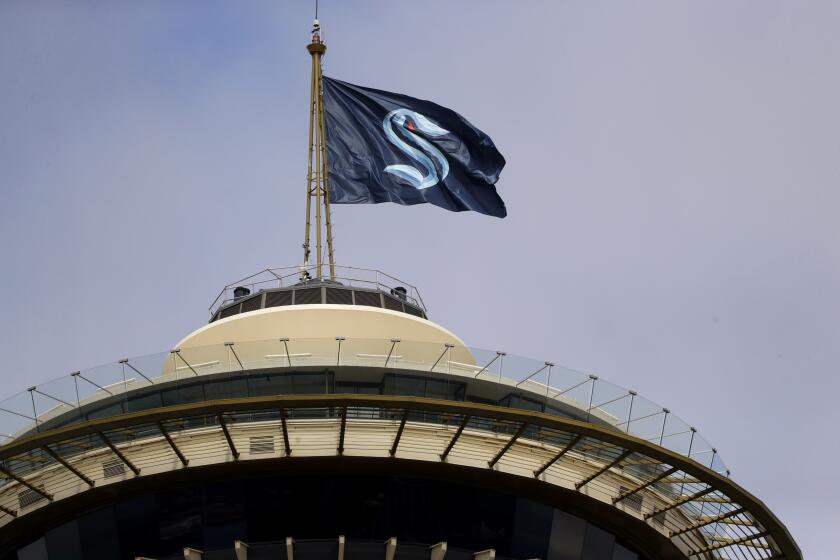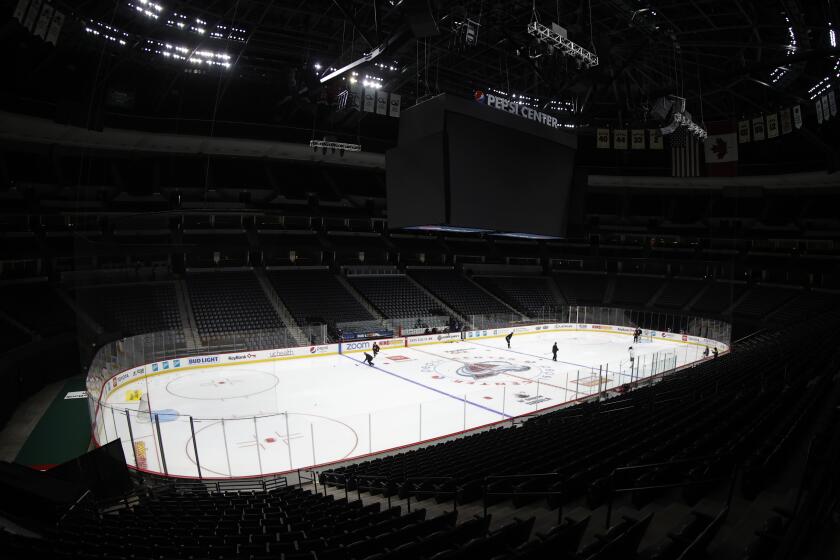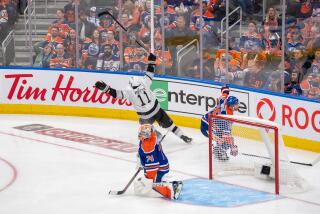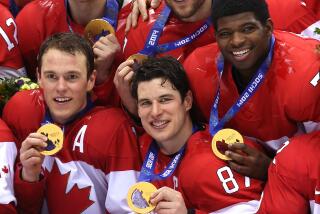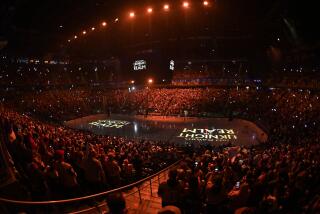NHL will deploy crowd noise and other techno wizardry to boost game atmosphere
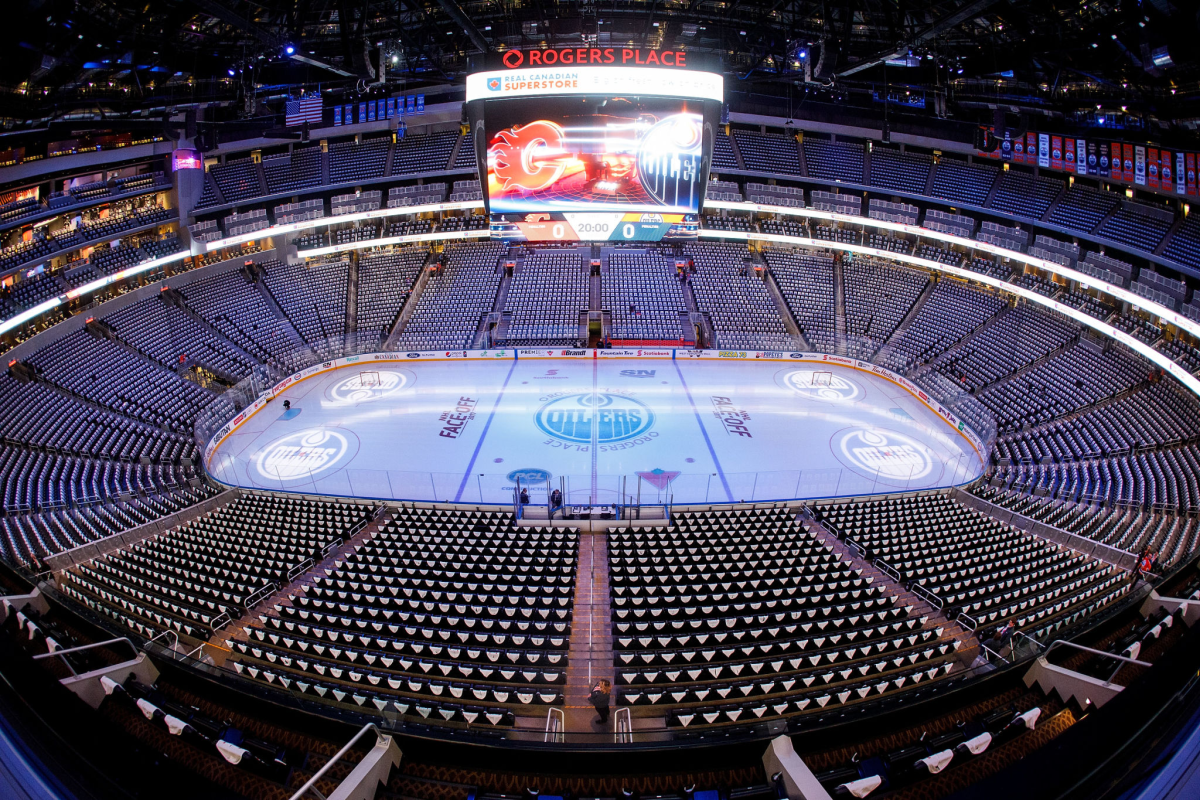
- Share via
The NHL won’t use cutouts of fans to fill seats that will be left vacant because of concerns related to the COVID-19 pandemic, but it will try to enhance the atmosphere for Stanley Cup playoff games at its hubs in Edmonton and Toronto by using LED screens, teams’ goal songs and play lists and other technology, league executives said during a webinar Friday and in a video released Thursday night on NHL.com.
Crowd noise will be piped in from EA Sports’ recordings of fans made during previous games at the participating teams’ arenas, and telecasts will be on a five-second delay to allow for editing of profanity that will be easier to hear because of the absence of the usual chants and cheers from fans. TV viewers will be able to see more angles than are available on standard telecasts because 32 cameras will be used instead of 20. Sportsnet will produce the feed of games involving the 12 Western Conference teams in the bubble in Edmonton and NBC will produce the games involving the 12 Eastern teams in the bubble in Toronto.
“We want to educate, entertain, and visually excite them,” Steve Mayer, the NHL’s senior executive vice president of events and entertainment, said of fans watching at home. “We’re going to bring these arenas to life through the art of video, audio and lighting.”
Frontline healthcare workers and social justice advocates will be honored at games, Mayer said, and videos that feature fans will be displayed in an effort to bring them “into” a game they will have to watch from afar.
The NHL’s Seattle Kraken, named for a mythical, tentacled sea monster, announced their name and colors on Thursday.
The NHL has granted extensive access within the bubble to only three writers — all of them writers for the league’s website, NHL.com. For comparison’s sake, the NBA has allowed 10 reporters prime access to games and interviews within its competition bubble near Orlando, Fla. “Increased numbers, increased risk,” deputy commissioner Bill Daly said when asked why the league had so severely restricted non-league-controlled media access.
NHL teams are finishing training camp in their respective cities, the third of the four planned phases of the Return to Play plan. Phase 4 will begin when teams travel to their assigned hubs on Sunday and play exhibitions next week. The revamped, 24-team playoffs are scheduled to start Aug. 1. The conference finals and Stanley Cup Final will be played in Edmonton, with a potential finishing date of Oct. 4.
Dr. Willem Meeuwisse, the league’s chief medical officer, said the frequent PCR testing of players, coaches, and other personnel for COVID-19 can be done with a 24-hour turnaround time “without detracting from the general public” and the need local residents might have to be tested. Daly said the confirmation of only two positive tests of 800 players tested during a five-day period last week “bodes well for our transition into Phase 4.”
Meeuwisse said the league expects some positive tests to turn up. “And we have a method and a process designed in advance to deal with that. And we’ll continue to consult with the local health authorities as that unfolds,” Meeuwisse said.
Commissioner Gary Bettman, who paused play March 12, called the process of devising a plan to finish the season “one of the most unique and challenging endeavors any of us have ever been involved with.” He added, “And first and foremost, and you’ve heard us say this all over again, health and safety is driving all of our decisions and all of our attention and focus. That is the primary aspect of what we have to accomplish over the next couple of months.
The NHL reported that two players tested positive for COVID-19 during the first five days of training camp out of 2,618 tests administered to over 800 players.
“It’s not a coincidence that the HUB cities are Toronto and Edmonton because of our focus on health and safety and where COVID-19 is and isn’t.”
Los Angeles had been a finalist to become a hub city but was eliminated in the late stages of the selection process because of a surge in COVID-19 cases in Southern California.
Teams will be sequestered in bubbles in the two hubs, with fencing systems built to keep them away from the public. They will be able to leave their respective hotels to visit restaurants and take advantage of recreational activities such as indoor and outdoor pools, soccer, pickleball, and cornhole.
“I will say that my level of confidence has increased along the way, and in particular since we’ve moved into Phase 3, mandatory training camp phase with over 800 players in group team building environments,” Daly said “The fact of the matter is I think I’m comfortable with the protocols and procedures we have in place, and more importantly, I’m comfortable with how the players seem to have embraced them and taken them seriously and are adhering to them.
“Knock on wood. As Gary said, we have a long way to go, but I’m certainly a lot more comfortable with where we are now than if you had asked me that question a month ago.”
More to Read
Go beyond the scoreboard
Get the latest on L.A.'s teams in the daily Sports Report newsletter.
You may occasionally receive promotional content from the Los Angeles Times.

